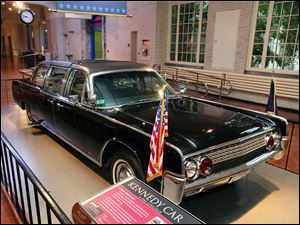
Car on display in Dearborn inspires silence, memories
11/17/2013
The car that carried President John F. Kennedy has been exhibited at the Henry Ford museum for several years. Admission is free to the museum on Friday.
DEARBORN, Mich. — The presidential limousine looks different than it did on Nov. 22, 1963, the day John F. Kennedy was fatally shot while riding in the convertible in Dallas.
But visitors to the Henry Ford museum in Dearborn still stop in their tracks when they spot the vehicle on display.
“I see them pass by and then slow down and stop and then look at the car and look at the label,” Curator of Public Life Donna Braden said.
The limousine still resonates as a symbol of that day nearly 50 years ago. Some stay silent upon approaching the exhibit.
“I think they’re all doing a personal commemoration and going back to their memories; the memories are very strong,” she said.
RELATED: Memories of Kennedy's 1960 campaign stop in Toledo
RELATED: Air Force One still a mobile museum
Visitors can check out the car and the rest of the museum on the anniversary of the assassination when, on Friday, the Henry Ford offers free admission.
The four-door convertible, a 1961 Lincoln Continental, was built at a Wixom, Mich., plant and modified in Cincinnati with special features befitting its presidential purpose.
Customized accoutrements included removable roof pieces, a hydraulic seat, and steps for Secret Service agents, according to Ms. Braden’s research.
After President Kennedy’s assassination, the car was armored and a permanent roof was installed, among other modifications that illustrated the shifting focus from presidential access and visibility to protection and security.
Presidents Lyndon B. Johnson and Richard Nixon both rode in parades in the car, and it was used as a backup for Gerald Ford and Jimmy Carter. During President Nixon’s term, a roof door was added so he could pop up during parades.
Ford Motor Co., from whom the Secret Service had leased the vehicle, donated it to the museum after it was retired from White House duty in 1977.
It took several years before the museum put it on public display, Ms. Braden said. Among the reasons why officials hesitated to highlight the car immediately is because President Kennedy’s children were still young, and the assassination was “still too close to people’s memories,” she said.
“It increasingly became an appropriate symbol of the presidency for us to exhibit and talk about, and now we just take for granted that we have the car,” Ms. Braden said.